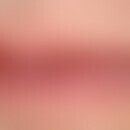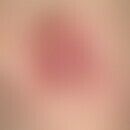Synonym(s)
EtiopathogenesisThis section has been translated automatically.
The mutations that are detectable in the tumor parenchyma show a UV-induced genomic signature (C>T or CC>TT) in the Tp53 gene as the main risk factor.
Other risk factors are:
- Chronic UV exposure
- Diabetes mellitus (Kuntz K et al. 2024)
- An increased risk factor for atypical fibroxanthoma and pleomorphic dermal sarcoma is suspected due to long-term use of hydrochlorothiazide (Kuntz T et al. 2024).
ManifestationThis section has been translated automatically.
Male patients with an average age of 70-80 years.
You might also be interested in
LocalizationThis section has been translated automatically.
face, hairless capillitium
ClinicThis section has been translated automatically.
The clinical aspect with an asymptomatic, skin-colored or reddish, firm lump or plaque corresponds to that of atypical fibroxanthoma. 50% of the tumors are ulcerated.
DiagnosticsThis section has been translated automatically.
The diagnosis is made on the basis of the clinical picture and histology. Immunohistochemistry is important for differentiation from other differential diagnoses.
HistologyThis section has been translated automatically.
Mostly poorly defined nodule affecting the cutis and subcutis (also deeper tissue structures) consisting of atypical, spindle-shaped or pleomorphic cells with vesicular or bizarre hyperchromatic nuclei. Bizarrely configured multinucleated giant cells and atypical mitoses are frequently found. The cells are CD34 negative (DD: Dermatofibrosarcoma protuberans) and constantly vimentin positive. The spindle cells are often positive for alpha smooth muscle actin, the macrophage-like cells for CD68. Occasionally a focal keratin expression is observed (so-called keratin-positive AFX). Numerous vessel incisions. Often focal haemorrhages, tumor necrosis and/or perineural infiltration.
TherapyThis section has been translated automatically.
Micrographic surgery according to Mohs or wide local excision with a sufficient microscopically controlled safety margin of 2 cm. There is a high tendency to local recurrence.
Internal therapyThis section has been translated automatically.
In metastatic or unresectable PDS, it is important to establish an individualized treatment plan. Immune checkpoint inhibitors are an option in off label use.
Progression/forecastThis section has been translated automatically.
10% chance of metastasis.
AftercareThis section has been translated automatically.
Follow-up in the form of clinical examinations is recommended at quarterly intervals for the first two years and lymphnote examinations every six months. In the third to fifth year, MSE and sonography are recommended every six months.
LiteratureThis section has been translated automatically.
- Ardakani NM et al. (2015) Pleomorphic dermal sarcoma withosteosarcoma-like and chondrosarcoma-like elements. Pathology 48:86-89. Griewank KG et al. (2014) TERT promoter mutations are frequent in atypical fibroxanthomas and pleomorphic dermal sarcomas. Mod Pathol 27:502-508.
- Kuntz T et al. (2024) Hydrochlorothiazide and increased risk of atypical fibroxanthoma and pleomorphic dermal sarcoma. J Dtsch Dermatol Ges 22:513-519.
- Mentzel T (2015) Fibrohistiocytic tumors of the skin: a heterogeneous group of superficially located mesenchymal neoplasms. Pathologist 36:79-88.
- Miller K et al. (2012) Pleomorphic dermal sarcoma: adverse histologic features predict aggressive behavior and allow distinction from atypical fibroxanthoma. Am J Surg Pathol 36:1317-1326.
- Tardío JC et al. (2015) Pleomorphic dermal sarcoma: a more aggressive neoplasm than previously estimated. J Cutan Pathol 43:101-112.
Outgoing links (4)
CD classification; Dermatofibrosarcoma protuberans (overview); Fibroxanthoma atypical; TP53 Gene;Disclaimer
Please ask your physician for a reliable diagnosis. This website is only meant as a reference.






